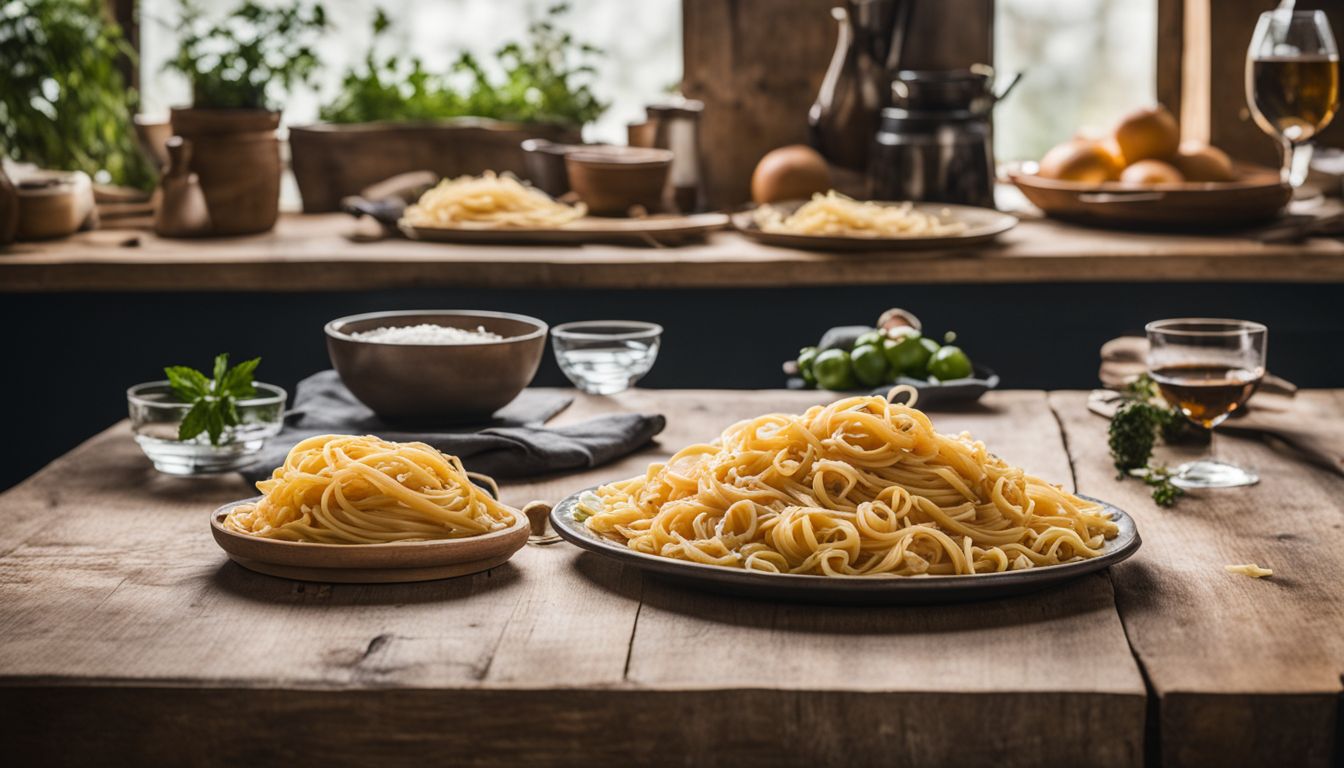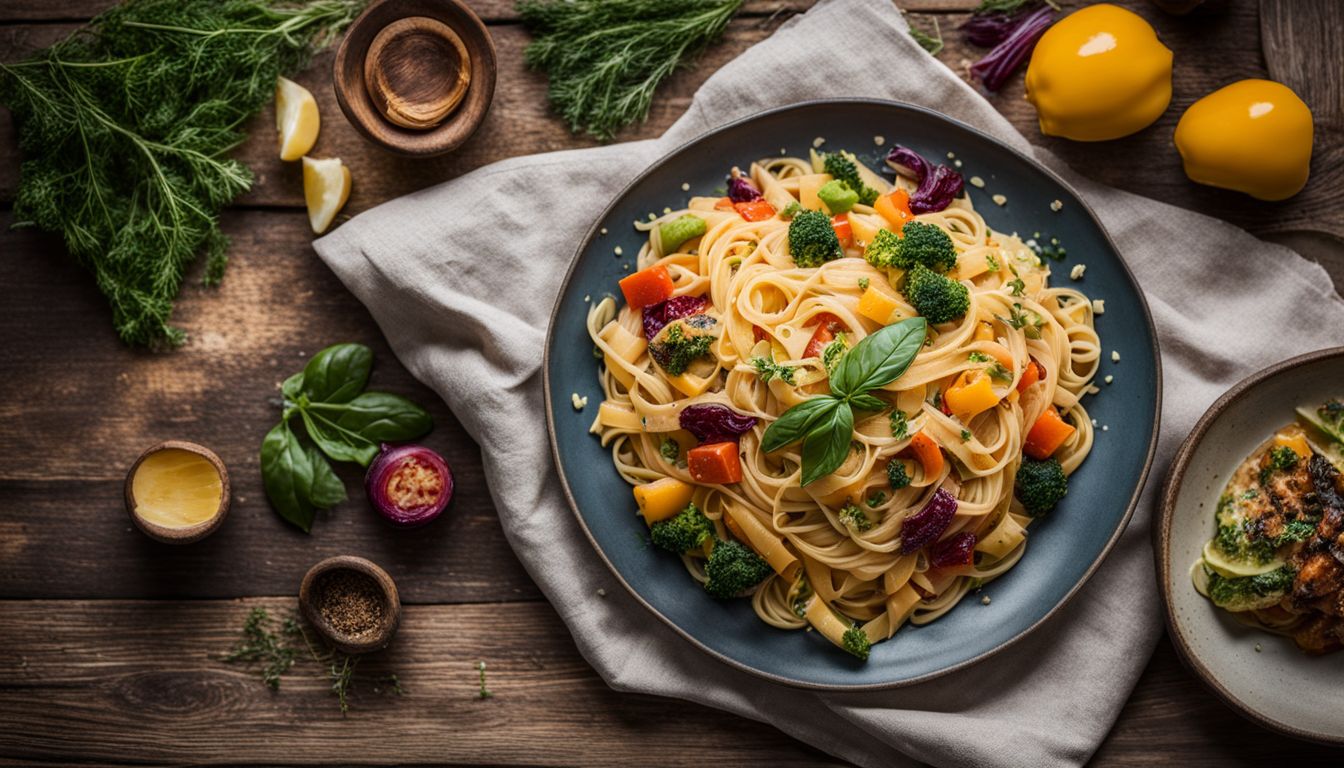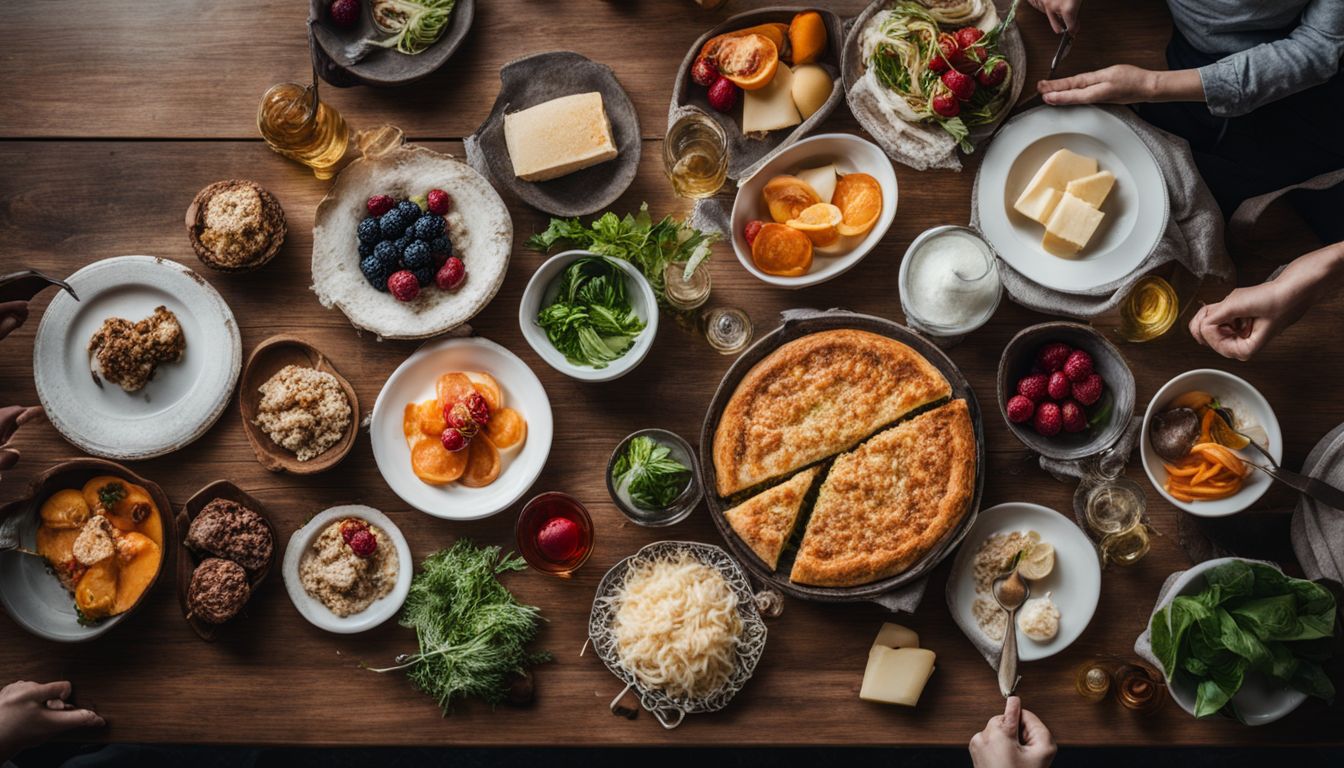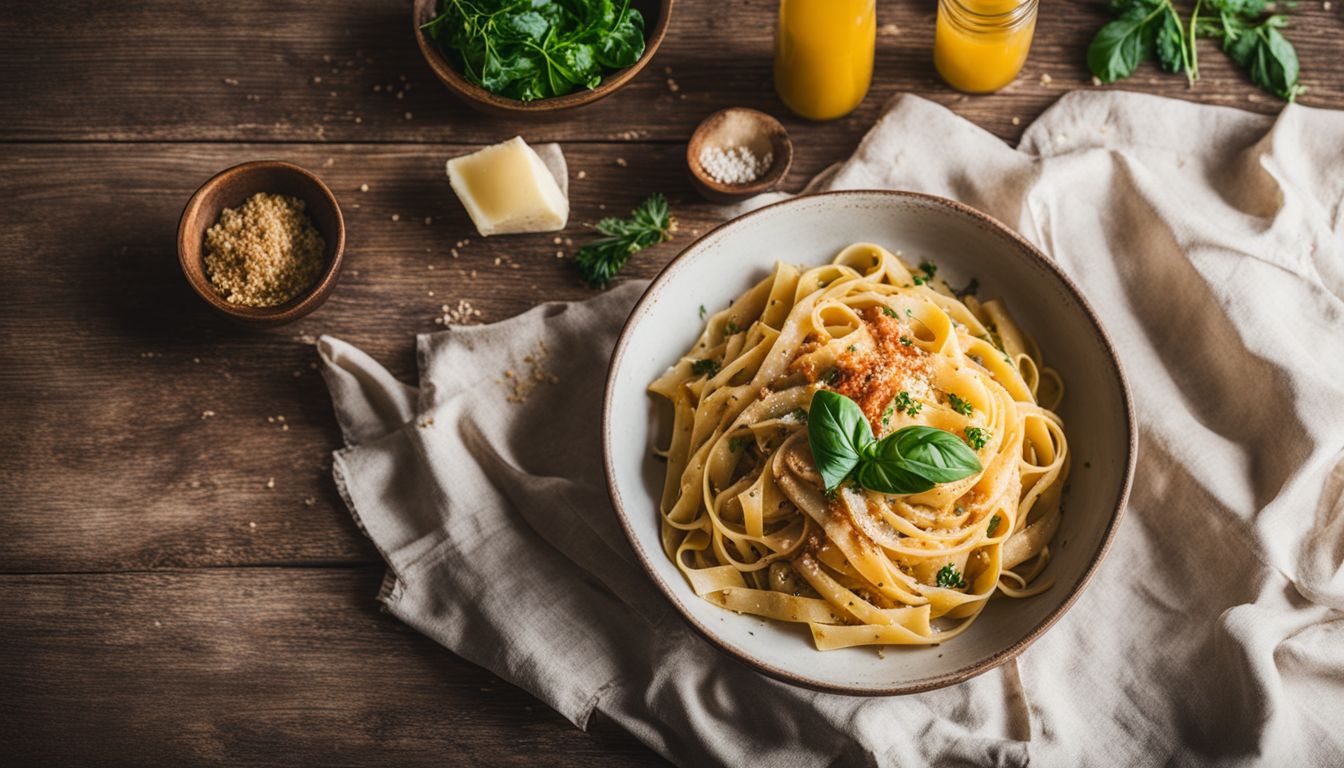Navigating the world of pasta can be tricky for health-conscious seniors, especially with so many labels claiming various health benefits. One key fact to consider is that not all gluten-free pasta is low in carbs.
Our guide dives into the truth behind gluten-free pasta options and their place in a low-carb diet, bringing clarity to your culinary choices. Read on for insights that could shape your next meal!
Key Takeaways
- Gluten – free pasta is not always low in carbs; it can be made with rice or corn flour which are high in carbohydrates.
- Low-carb options for pasta include vegetable-based alternatives like zucchini noodles and spaghetti squash.
- Net carbs matter on a keto diet and traditional gluten – free pastas may have too many to fit the plan.
- Look for gluten-free pastas made from lower-carb flours like almond or coconut if you’re watching carb intake.
- Reading nutrition labels is essential to find the right type of gluten – free pasta that aligns with dietary needs.
Understanding the Difference Between Gluten and Gluten-Free Pasta

Gluten-free pasta swaps out traditional wheat ingredients. It uses alternatives like rice, corn, or quinoa flour instead of wheat. This change makes it safe for people with celiac disease or gluten intolerance.
Gluten acts as a glue that holds regular pasta together, giving it its chewy texture. Pasta without gluten tends to be softer and may break apart more easily if overcooked.
Many seniors are choosing gluten-free options even if they don’t have an allergy or intolerance. They might think these pastas are lower in carbs or better for weight management. But here’s the key: Always check the labels because not all gluten-free pastas are low-carb! Moving on, let’s explore the nutritional value these pastas offer and see how they stack up against regular ones.
The Nutritional Value of Gluten-Free Pasta

Moving beyond the gluten content, let’s look at what’s inside gluten-free pasta. It often contains alternative grains like rice or corn, which provide varying levels of vitamins and minerals.
Some types are made with quinoa or amaranth, boosting the protein content. Gluten-free pasta can also be a good source of dietary fiber, especially if it includes ingredients such as bean flours.
Many brands add nutrients to make their pasta healthier. This process is called fortification. They might include B vitamins like folic acid, which is important for heart health. Just remember that not all gluten-free pastas are created equal in terms of nutrition – some may have added sugars or less fiber than others.
Always read labels to choose a brand that matches your dietary needs.
The Difference Between a Low-Carb Diet and a Gluten-Free Diet

A low-carb diet focuses on cutting back on carbohydrates like sugar, bread, and pasta. People often choose this diet to lose weight or manage diabetes. It means eating less of foods high in carbs and more of foods rich in protein or fats.
Think meats, eggs, some nuts, and certain vegetables.
On the other hand, a gluten-free diet avoids gluten. Gluten is found in wheat, barley, and rye. This diet is essential for those with celiac disease or gluten sensitivity because it helps prevent stomach pain and other symptoms.
So, while both diets limit certain types of food, they do so for different reasons. A low-carb diet isn’t always gluten-free since some low-carb foods still have gluten. And not all gluten-free foods are low in carbs – many substitute flours can be high in them!
Is Gluten-Free Pasta Low Carb?

Navigating the world of pasta choices can be tricky, especially when you’re looking to reduce carbs. Many health-conscious seniors find themselves pondering whether swapping traditional noodles for gluten-free options means they’re also cutting down on carbohydrates—let’s dive into the truth behind gluten-free pasta and its place in a low-carb lifestyle.
Does Gluten-Free Pasta Have Less Carbs?
Gluten-free pasta often gets mixed up with being low-carb, but this isn’t always true. Most gluten-free pastas still have carbs because they are made from rice flour or corn flour.
These ingredients can have as many carbs as regular wheat pasta. Some brands make special low-carb, gluten-free pasta using almond or coconut flour, which does cut down on the carbs.
For fewer carbs, try pasta made from vegetables like zucchini noodles or spaghetti squash. These options are naturally lower in carbohydrates and fit well into a low-carb diet plan.
They’re also packed with nutrients which is great for your health. If you’re watching your carb intake, check the labels carefully before choosing a gluten-free pasta alternative.
Is Whole Grain Pasta Low Carb?
Whole grain pasta is often chosen for its fiber and nutrients. But, it’s not low in carbs. Even whole grain versions have a similar carb count to regular pasta. This can be tricky if you’re trying to cut back on carbs.
For those watching their carb intake, other options may suit better. Think about zucchini noodles or spaghetti squash. These provide the pasta experience without loading up on carbs.
They fit nicely into a low-carb or keto diet plan. Whole-grain pasta isn’t the go-to choice when reducing carb consumption, which is the goal.
Is There A Gluten-Free Pasta That Has No Carbs?
Switching focus from whole grain pasta, you might wonder about gluten-free options without any carbs at all. You are in luck! There are indeed types of gluten-free pasta that have no traditional carbs.
These special pastas often use ingredients like zucchini noodles, spiralized veggies, or spaghetti squash instead of regular flour. They’re not only free from gluten but also low in carbs and high in other nutrients.
Look for vegetable-based alternatives if you want a pasta experience with minimal carbs. These creative twists on classic dishes can support your health goals while satisfying those comfort food cravings.
Just remember that portions still matter to maintain a balanced diet—enjoy these innovative pastas as part of an overall nutritious meal plan.
Is Gluten-Free Pasta Suitable for a Keto Diet?
When considering a keto diet, the key question is whether gluten-free pasta makes the cut for this low-carb lifestyle. Hearing “gluten-free” might paint a picture of carb-light fare, but let’s dive into the grains of truth behind its compatibility with ketosis — because sometimes, what’s missing on one front gets piled high on another.
Can You Eat Pasta if You Are On a Keto Diet?
You might miss pasta if you’re on a keto diet. Regular pasta packs too many carbs for keto. But don’t worry, there are options! Zucchini noodles and shirataki noodles are great swaps.
These alternatives keep you within your daily carb limit while satisfying that pasta craving.
Reading labels is key when picking gluten-free pasta for keto. Look for types with lower carbs to stay on track. Just remember, traditional gluten-free pastas still have more carbs than most keto diets allow.
Always check the numbers and enjoy smart pasta choices that fit your low-carb lifestyle!
Understanding Net Carbs and Daily Carb Limits
Net carbs are what you get when you subtract fiber from the total carbs. This number matters because it shows how much your blood sugar might go up. For example, if a food has 30 grams of carbs but 5 grams of fiber, its net carb count is 25 grams.
Keeping an eye on net carbs helps stay within daily limits, especially for low-carb or keto diets.
A low-carb diet usually means eating 50 to 100 grams of carbs each day. Keto diets go even lower, with just 20-30 grams daily. Think about this when choosing foods like pasta because one serving can use up a lot of your carb limit quickly.
Gluten-free pasta often packs around 35 to 44 grams of net carbs per serving – that’s important to remember for meal planning!
Traditional Gluten-Free Pasta and Carb Limits
Understanding net carbs is vital when looking at traditional gluten-free pasta. Many people think this kind of pasta will help them stay low on carbs. However, that’s not always true.
Gluten-free pastas made from rice flour, corn, or quinoa can pack a punch with 35-44 grams of net carbs per serving. This amount takes up a big chunk of the daily carb limit for someone on a keto or low-carb diet.
Eating these types of pasta could make it hard to keep carbs in check. It’s important to read labels and look at the carb content if you’re trying to cut down on carbs. Keep an eye out for gluten-free pastas with fewer net carbs if you want to enjoy pasta without using up your carb allowance for the day.
Does Gluten-Free Pasta Belong In A Keto or Low-Carb Diet?
Gluten-free pasta can make it into a keto or low-carb meal plan, but you have to choose wisely. Rice flour or corn-based pastas still pack a lot of carbs, so they’re out if you’re keeping strict track of your carb intake.
On the other hand, look for gluten-free options made from almond or coconut flour. These types are much lower in carbs and fit well with a low-carb lifestyle.
For those looking to stay true to their keto goals, consider veggie alternatives like zucchini noodles or spaghetti squash instead. They are not only delicious but also naturally low in carbohydrates.
These alternatives keep your meals interesting and help maintain nutritional balance without missing out on the joy of twirling something “pasta-like” on your fork!
Gluten-Free Pasta Overview
Let’s dive into the world of gluten-free pasta and unravel its mysteries—is it truly a healthier option, or just another food trend? Before we tackle those persistent myths, understanding what sets gluten-free pasta apart from traditional varieties is key to making informed choices for your wellbeing.
Is Gluten-Free Pasta Healthier?
Many people think gluten-free pasta is a healthier choice. The truth is it depends on the ingredients. Some varieties use rice or corn flour, which can raise your blood sugar just like regular pasta.
They may have a grainy texture and nutty flavor, but their carb content isn’t always lower.
Gluten-free does not mean weight loss-friendly either. If you’re looking to cut down on carbs or calories, look at the label closely. Healthier options might be pastas made from almond or coconut flour, since these are lower in carbs and better for blood sugar control.
Remember, whole grains are good for you too! They provide more nutrients than refined grains found in some gluten-free pasta brands.
Avoid These Common Myths Surrounding Gluten-Free Pasta
Gluten-free pasta often gets tangled up in myths. Let’s set the record straight for our health-conscious seniors.
- Myth 1: Gluten-Free Pasta is Always Low in Carbs
- Myth 2: Eating Gluten-Free Pasta Will Help You Lose Weight
- Myth 3: All Gluten-Free Pasta Tastes Bad
- Myth 4: Gluten-Free Pasta Lacks Nutrients
- Myth 5: Only Those with Celiac Disease Should Eat Gluten-Free Pasta
- Myth 6: Keto Dieters Can’t Have Any Pasta
- Myth 7: There’s No Difference Between Various Types of Gluten-Free Pastas
- Myth 8: A Gluten-Free Diet is Automatically Healthier
The Benefits of Gluten-Free Pasta for Seniors
For seniors seeking a health-conscious twist on their favorite pasta dishes, the switch to gluten-free options can be a game-changer. Not only does it cater to those with dietary restrictions, but it also opens up a world of benefits that align with the nutritional needs and lifestyle considerations unique to older adults.
Overall Health Benefits of Gluten-Free Pasta
Gluten-free pasta is a great choice for seniors who deal with gluten-related disorders or simply want to improve their digestive health. It offers a tasty alternative that’s easier on the stomach than traditional wheat flour pasta, which can cause discomfort like bloating and constipation.
Seniors with diabetes may find gluten-free options beneficial too, due to their typically lower glycemic index. This means they won’t spike blood sugar levels as much, helping maintain better control over diabetes.
Eating gluten-free pasta might also help in weight control efforts since many varieties are made with ingredients that have fewer calories and carbs compared to regular pasta. For those watching their carbohydrate intake or managing type 2 diabetes, these alternatives can be part of a healthy diet without sacrificing the joy of eating pasta dishes.
Next up, let’s explore the convenience of switching to gluten-free pasta for seniors.
The Convenience of Gluten-Free Pasta
Gluten-free pasta is a game-changer for seniors who have to watch their diet due to health issues like celiac disease or gluten intolerance. It’s easy to cook and fits perfectly into a balanced meal without the worry of triggering any adverse reactions.
Plus, it offers the same satisfying taste and texture as traditional pasta—think of that slightly nutty flavor and firm bite—but without the gluten that can cause discomfort.
Seniors will find a variety of these pastas made from different ingredients such as rice, corn, or quinoa at their local grocery store. There’s no need to miss out on favorite dishes like spaghetti Bolognese or macaroni salad! This accessibility makes it simpler than ever for older adults to enjoy a delicious bowl of pasta any day of the week.
The Impact of Gluten-Free Pasta on a Senior’s Diet
Gluten-free pasta can be a smart choice for older adults, especially those with gluten sensitivities. It’s easier on the stomach and helps prevent discomfort after meals. Seniors looking for better blood sugar control might find gluten-free options helpful due to their lower glycemic index.
High in protein and fiber, this pasta also supports a healthy diet.
For seniors watching their health, gluten-free pasta brings valuable nutrients to the table. Iron and magnesium are important for keeping bodies strong. Enjoying a bowl of quality gluten-free pasta means getting similar calories as regular pasta but with added benefits like increased micronutrients that support overall well-being without upsetting the digestive system.
Best Senior-Friendly Meal Kits for Gluten-Free Pasta
Navigating meal prep can be a hurdle for health-conscious seniors, especially when it requires special dietary considerations like gluten-free options. That’s where senior-friendly meal kits come into play; they’re tailored to make dining hassle-free and enjoyable without compromising on nutritional value or taste preferences.
These kits cater specifically to those looking for gluten-free pasta dishes that are both delicious and easy to prepare.
Best Meal Kits for Organic Ingredients: SunBasket
SunBasket shines when it comes to organic ingredients. They know that health-conscious seniors care about what goes into their meals. That’s why they pack their meal kits with high-quality, organic produce and proteins.
You get delicious recipes that fit right into a gluten-free lifestyle. Plus, options like zucchini noodles keep things low-carb and nutrient-rich.
Seniors who choose SunBasket can trust they’re getting the best for their health without sacrificing taste or variety. Each kit is an adventure in flavor that supports dietary needs, whether you’re keeping carbs low or following a keto diet.
Now, let’s check out how Home Chef makes prep work hassle-free for seniors who love cooking at home!
Best Meal Kits for Hassle-Free Prep Work: Home Chef
Home Chef makes cooking easy for seniors. Their meal kits are perfect if you want a quick and simple way to eat well. You’ll find fresh ingredients all measured out, with step-by-step instructions.
There’s no need to fight the crowds at the grocery store or guess what’s for dinner. Home Chef delivers right to your door. Plus, they offer gluten-free options, so if you’re avoiding gluten, there’s something delicious for you too.
Seniors can trust Home Chef for tasty meals that won’t take all day to make. Enjoy a variety of recipes each week without worrying about prep work or cleanup. Keep your diet balanced and full of flavor with these convenient meal kits designed just for you.
Best Heat-and-Eat Frozen Meals: Magic Kitchen
Magic Kitchen shines for seniors who need quick, healthy meals. Their heat-and-eat frozen options are just right for older folks with dietary limits or celiac disease. These meals pack a nutritious punch with low sodium and plenty of vitamins.
Seniors managing diabetes or sticking to low-carb or keto diets will find Magic Kitchen’s gluten-free pasta a perfect fit.
Dinners become easier and stress-free with these ready-to-go dishes. Just warm them up to enjoy a delicious meal without the hassle of cooking from scratch. Perfect for seniors looking to keep their weight in check and eat right without giving up on taste or variety.
Best Meal Kits for Seniors Who Live Alone: Snap Kitchen
Moving from frozen meals to fresh options, Snap Kitchen steps in with meal kits perfect for seniors living solo. They deliver delicious dishes that fit a gluten-free and low-carb diet without any hassle.
Seniors can enjoy a variety of tastes and flavors without spending hours in the kitchen. With Snap Kitchen, everything is straightforward: choose your meals online, get them delivered to your door, heat, and eat.
It’s that simple! Each dish is carefully crafted to provide the nutrients needed for a healthy lifestyle.
Snap Kitchen takes pride in their dedication to wholesome ingredients that support seniors’ health. For those avoiding high carbs but still craving pasta, Snap Kitchen has got it covered.
Their menu includes creative low-carb alternatives that are just as satisfying. You won’t find traditional pasta here, but you’ll discover tasty veggie noodles packed with vitamins and minerals instead.
These smart swaps keep meals exciting and nutritionally balanced – ideal for any senior aiming to maintain good health while enjoying every bite.
Best Meal Delivery Service for Sticking to a Diet: Factor
Factor stands out for seniors who are serious about sticking to their diet. Their meals are made with health in mind, perfect for those watching their carb intake or following specific dietary plans.
Factor uses fresh, high-quality ingredients that align well with a balanced diet, helping you stay on track without the work of counting carbs or preparing complex recipes.
They offer a range of meal options designed by dietitians, ensuring nutritional needs are met while keeping flavors bold and satisfying. Whether aiming for weight loss or just healthy eating habits, Factor delivers right to your door—making it easier to maintain a nutritious lifestyle without sacrificing taste or convenience.
Best for a Gluten-Free Diet: Green Chef
Sticking to your diet goals gets easier with Green Chef. They focus on delivering meals that are both gluten-free and packed with organic ingredients. This means seniors can enjoy tasty dishes without the worry of consuming gluten.
Not only does Green Chef cater to those with gluten intolerances, it’s also perfect for anyone following a low-carb, grain-free or even a keto or paleo diet.
Meals from Green Chef come straight to your door with easy-to-follow recipes. You get everything you need to make delicious pasta dishes that fit right into a healthy, gluten-free lifestyle.
Plus, these meal kits save time in the kitchen and take out the stress of meal planning. For seniors especially looking for nutritious options that are kind to their dietary needs, Green Chef stands out as an excellent choice.
How to Choose the Best Senior-Friendly Meal Delivery Kit
Choosing the best meal delivery kit starts with your health needs. Look for ones that offer low-sodium, high-fiber options if you have heart concerns or dietary restrictions. Consider kits rich in vitamin C and polyunsaturated fatty acids to support your immune system and heart health.
Check the menus for whole-grains and lean proteins that boost energy levels.
It’s also about ease of use. Make sure meal kits require minimal prep work, especially if you struggle with grip strength or get tired easily while cooking. The right service will cut down on time shopping for groceries too, sending everything straight to your door.
Lastly, taste matters! Opt for a service offering dishes you love that are both healthy and delicious. This way, it doesn’t feel like a diet but a satisfying way to eat well every day.
Conclusion
Remember, gluten-free pasta isn’t always low in carbs. You’ve got to read the labels! Some gluten-free pastas might fit into a keto or low-carb diet if they’re from almond or coconut flour.
Veggies like zucchini noodles are great low-carb options too. Look for these when you crave pasta but need to watch your carb intake. Stay healthy and enjoy your meals with the right info at hand!
FAQs
1. What does gluten-free pasta contain if not gluten?
Gluten-free pasta often replaces wheat with other grains or starches, using ingredients like rice flour and cornstarch that still have carbs.
2. Can seniors on a low-carb diet eat gluten-free pasta?
Seniors should check labels since gluten-free doesn’t mean low-carb; these pastas can still be high in carbohydrates, even without the gluten.
3. Why do some people need to avoid gluten?
People with celiac disease or a gluten allergy need to steer clear of it because their bodies react badly to this protein found in certain cereals, damaging their small intestine.
4. Does eating gluten-free pasta help you lose weight?
Not necessarily — while some think it’s healthier, you’d have to consider the overall nutritional profile and how it fits into your diet for weight loss.
5. Is there any difference in nutrients between regular and gluten-free pasta?
Yes! Gluten-free versions might lack certain vitamins and fibers unless they’re fortified foods, which means added nutrients make them better for you.
6. Are all types of carbs bad for health-conscious seniors?
Nope – our bodies need carbs as fuel but go for complex carbohydrates from wholegrain sources over simple sugars; they give steady energy and keep the heart happy too!





